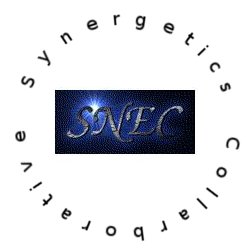|
101.01 Synergy means behavior of whole systems unpredicted by the behavior of their
parts taken separately.
102.00 Synergy means behavior of integral, aggregate, whole systems
unpredicted by behaviors of any of their components or subassemblies of their
components taken separately from the whole.
-- R. Buckminster Fuller, Synergetics, 1975
|

|
Synergetics, in the broadest terms, is the study of spatial complexity, and as
such is an inherently comprehensive discipline. ... Experience
with synergetics encourages a new way of approaching and solving problems.
Its emphasis on visual and spatial phenomena combined with Fuller's holistic
approach fosters the kind of lateral thinking which so often leads to creative
breakthroughs.
-- Amy Edmondson
|
Education for cooperation and synergy: Key to success at the Synergetics Collaborative (SNEC)
As a collaborative organization, the Synergetics Collaborative (SNEC) depends on the effective collaboration of its members to succeed. Education and training play a crucial role in equipping SNEC members with the knowledge and skills they need to work together effectively. In this article, we will look at the importance of education for collaboration and synergy, and how it can contribute to achieving SNEC's goals.
Training is essential for affordable papers login to successful collaboration because it helps build a shared understanding of the project's objectives and goals. It also helps to create a common language and set of expectations that all team members can understand and utilize. In addition, training can help build trust among team members and create a climate of cooperation and mutual respect.
Understanding The Importance Of Collaboration
Collaboration is at the heart of SNEC's work, and members should understand the importance of collaboration and how it can lead to successful outcomes. Education and training programs should include instruction on effective collaboration, such as how to communicate effectively, how to build trust, and how to manage conflict. Participants should also learn how to recognize and utilize each other's strengths to achieve common goals. In addition, participants should be encouraged to take risks and think creatively so that they find innovative solutions to problems. Finally, participants should be encouraged to build long-term relationships with their colleagues to foster a culture of collaboration within the SNEC.
Building Synergies For Innovation And Creativity
Synergy is the interaction of two or more actors to produce a joint effect that is greater than the sum of the effects of each actor individually. Education and training should focus on creating synergies between SNEC members, as this can lead to innovation and creativity. Members should learn how to think outside the box and generate new ideas by combining their skills and experience. Training in techniques such as brainstorming and design thinking can help members develop the skills needed to work together and build synergies. Additionally, members should be encouraged to collaborate by creating joint projects and initiatives that can benefit the entire SNEC.
Leveraging Technology For Collaboration And Synergy
Technology can play a significant role in facilitating collaboration and synergy among SNEC members. Education and training programs should include instruction on the use of collaboration tools such as video conferencing, online collaboration platforms, and project management software. Members should also learn how to use technology to enhance creativity and innovation, such as using virtual reality to visualize concepts and projects. Additionally, SNEC should provide resources for members to share ideas and best practices, such as webinars, forums, and chat rooms..
Developing A Culture Of Collaboration And Synergy
A culture of collaboration and synergy should be developed within the SNEC to ensure that its members work together effectively. Education and training should focus on building a shared vision and values that support collaboration and synergy. Members should also learn how to build trust and respect, as these are important elements of successful collaboration. A culture of collaboration and synergy should also be reflected in the SNEC's policies and procedures, such as how decisions are made and how resources are allocated.
Finally, education and training are crucial to building cooperation and synergy among SNEC members. By providing instruction on how to collaborate effectively, build synergies, utilize technology, and develop a culture of cooperation and synergy, SNEC can achieve its goals and objectives more efficiently and effectively. By investing in education and training, SNEC can create a community of members who have the knowledge and skills necessary to work together and generate innovative solutions.
Return to the SNEC web site
Please send comments and suggestions to the SNEC webmaster.
